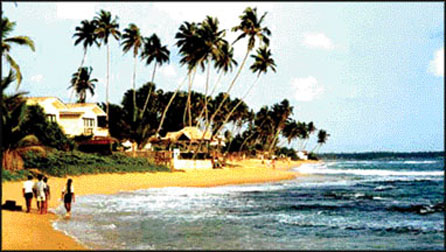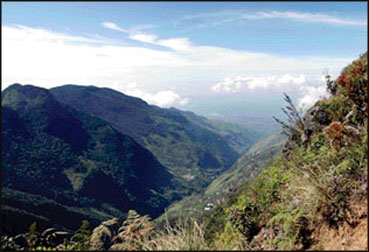
More about place names
At the end of our tour on September 7, I said I'd take you on another
tour of places with unusual or unfamiliar names. So let's set out.
Today our first stop is up in the hills at Nuwara Eliya.
This place name is often translated as 'City Lights'. This
translation is incorrect. Light is only one meaning of the Sinhala word
'Eliya'.
|

Hikkaduwa |
Eliya - plain
A level tract of land, a plain or table-land is also an 'eliya'. I
can see your eyebrows going up and you are itching to ask me, "What? A
plain, a flat land up among those hills!!"
Yes, the town of Nuwara Eliya is on a plain at the foot of
Pidurutalagala. The peak reaches 8,280 feet, and 2,000 feet below at the
foot of the mountain is the plain of Nuwara Eliya. Many Englishmen who
came there in the early days of British rule that is in the 19th century
- wrote about 'the plain of Nuwara Eliya, with a babbling stream flowing
through it'.
There are two other 'eliyas' in this region. Sita Eliya - Sita's
plain. Legend says this is where the beautiful princess Sita was kept a
prisoner by Ravana who abducted her (brought by force) from India. Hawa
Eliya - Rabbit Plain must have been the home and playground of thousands
of rabbits.
Further on in Uva, and at a higher elevation and larger in extent
than Nuwara Eliya, was another plain which was called Maha Eliya - Great
Plain, by the local people.
After it was named Horton Plains to commemorate Robert William
Horton, Governor of the colony Ceylon (1829-1834), the Sinhala name Maha
Eliya gradually went out of use. Now, even the textbooks mention Horton
Tenna (tenna is flat land) not Maha Eliya.
Place names ending in eliya are not confined to the hill country.
There is Kan Eliya, a forest reserve in the Galle district. Kal Eliya is
a village off the Colombo-Negombo road close to Ja-Ela, and Kal-Eliya is
on the road from Pasyala to Mirigama. Both are in the Gampaha district.
Kal means beautiful; so Kala Eliya may be a beautiful tract of open
level ground.
Kala Eliya could mean tract of level land that has been cleared of
jungle (eli kala) and made habitable and suitable for cultivation.
While these other plains have ordinary words like Kala, Maha and Hawa
attached to them, how did Nuwara Eliya get its high-sounding name? A 'nuwara'
is a place where a king or member of the royal family resides. Dona
Catherina, wife of King Senarath and later Queen in her own right, is
said to have taken refuge there when she was driven from her capital by
the Portuguese in 1628. Another oral tradition says a king fled to this
plain to escape the Portuguese in 1610. So Nuwara Eliya can well be
translated as 'Royal plain'.
Landa - wood
Once a student asked me if there was any connection between his
school Nalanda and the village Nalanda in the Matale district. None at
all. The college is Nalanda (h) with a long a at the end, named after
the famous college for bhikkhus in India (in the State of Bihar), in the
Fifth Century.
The village in the Matale district is Na-landa, a wood or jungle of
Na (iron-wood) trees. Na must have grown wild in this area; Na-mal Uyana,
the famous rose quartz hill, is not far from Nalanda. Other places with
names ending in 'landa' must have once had woods or jungles of trees
that gave these places their names. There is Koslanda, a jak wood in
lower Uva, Peralanda is a railway station on the Ragama - Negombo line.
Nuwara Eliya's Asokaramaya is in Boralanda. The famous plumbago (lead)
mines are in Dodangaslanda in the Kurunegala district, and Batalanda in
the Gampaha district, once had a house of detention for political
offenders.
All these places are named after a tree. I am not sure what 'bora' in
Boralanda stands for. It could mean muddy. With all that rain in Nuwara
Eliya, Boralanda could well be a muddy wood.
Golla - dense wood
|

Horton Plains |
Golla is also a wood, but here the trees are crowded together. It is
a dense wood unlike the landa where the trees are scattered - a sparse
wood. There is Horagolla, the home of the Bandaranaikes and Polgolla,
the site of a dam across the Mahaveli not far from Kandy.
Pe/pey - foot of a tree
Dompey, Halpey, Talpey, Meepey, Noopey, Madampey and Dehigaspey are a
few place names ending in pey. There are many more. Pey is foot, the
same as paada and paya. These villages and towns were originally hamlets
at the foot of a tree with large spreading branches. Two or three
families going in search of a new place to settle down would have rested
here and finding the place suitable would have decided to go no further.
Kaduwa - jungle
What type of sword is Hikkaduwa? What are the other swords in other
districts - Waskaduwa, near Kalutara, Tamankaduwa, in the NCP, Elkaduwa
(Matale district) and Parakaduwa (Ratnapura district.
Kaduwa in place names means jungle, and Hikkaduwa, earlier Sipkadawa
is a coral jungle.
Though depleted now, it must have been a real coral jungle at the
time Totagamuwe Sri Rahula Thera and others wrote the Sandesa poems in
the 15th Century. Sipkaduwa is mentioned in many Sandesa poems. You know
the meaning of the Sinhala word 'Sippi' - sea shells.
How did Yakkaduwa, a village in the Gampaha district get this name?
Long, long ago, it could have been a colony of 'Yakkhas', one of the
original tribes of Sri Lanka.
Try to do your own research on place names.
- Sumana Saparamadu
|
